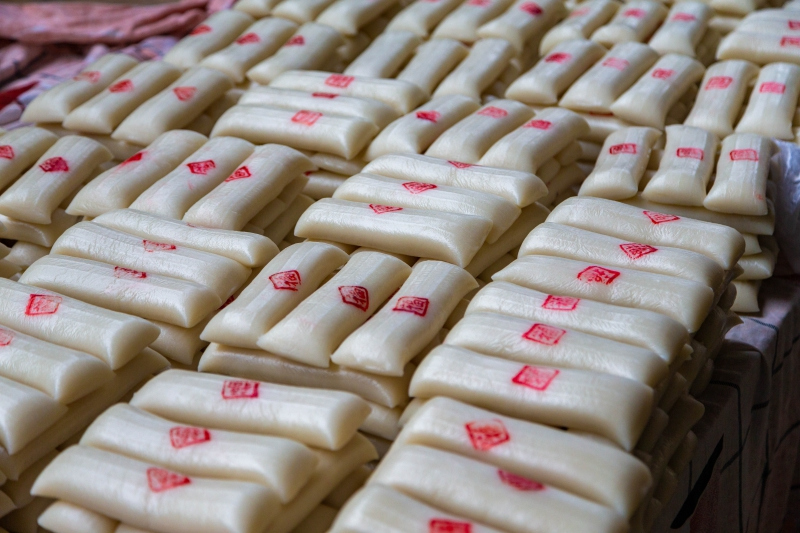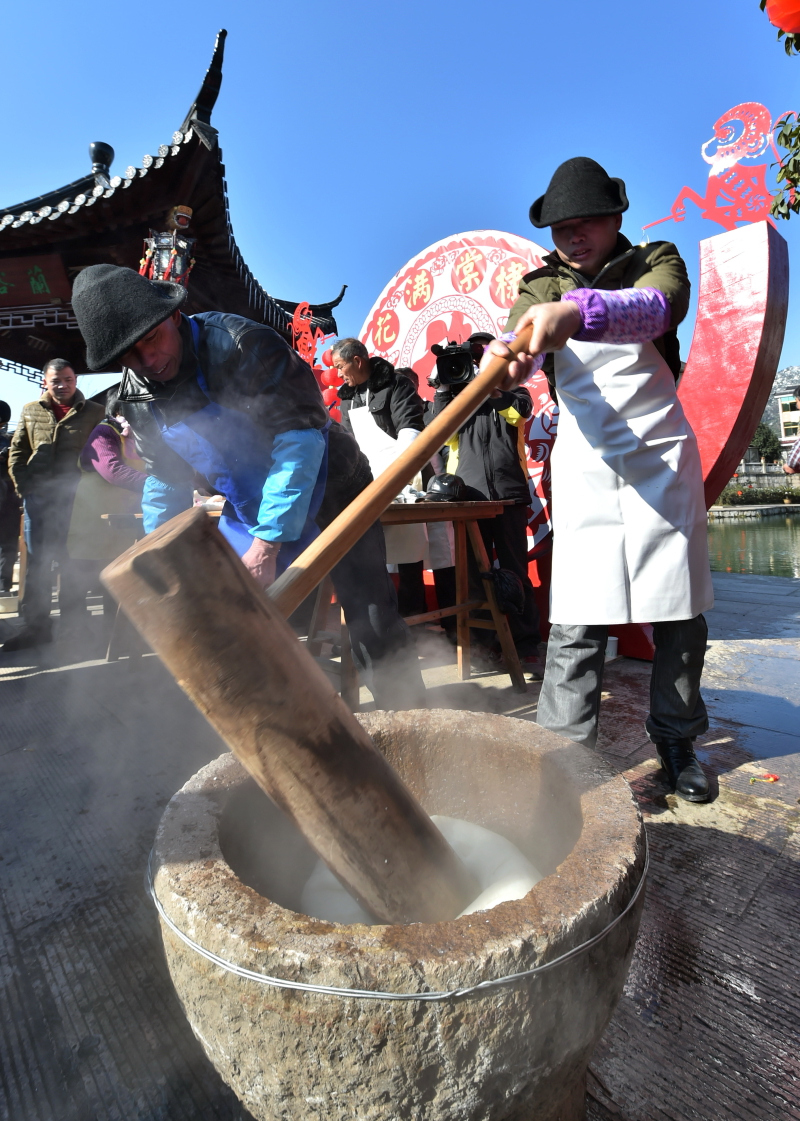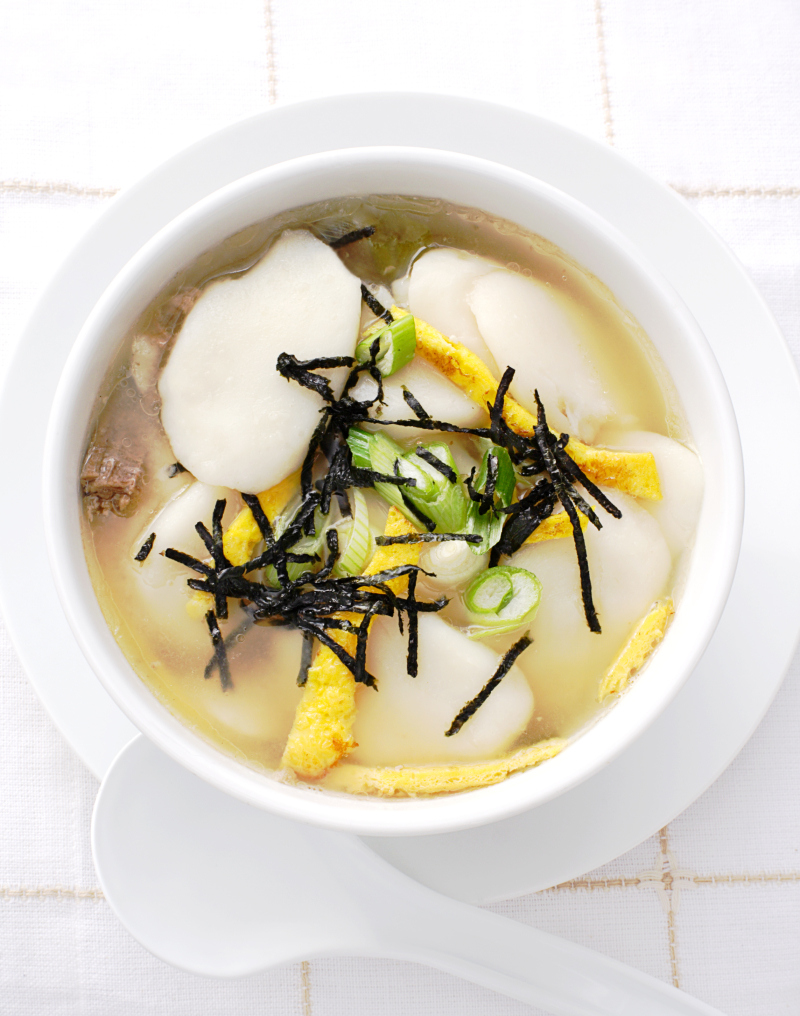Niangao, sometimes translated as year cake or Chinese New Year’s cake, is a food prepared from glutinous rice and consumed in Chinese cuisine. While it can be eaten all year round, traditionally it is most popular during Chinese New Year. It is considered good luck to eat during the traditional celebration time, because is a homonym for “higher year.” The Chinese word 粘 (nián), meaning “sticky”, is identical in sound to 年, meaning “year”, and the word 糕 (gāo), meaning “cake” is identical in sound to 高, meaning “high or tall”. As such, eating has the symbolism of raising oneself taller in each coming year.

The genesis of this ceremonious food for the Spring Festival varies in different folk stories and legends. in eastern Zhejiang has something to do with two different folk stories about the genesis. People of Ningbo love very much indeed. The making in Ningbo goes back to a written description of the Northern Song Dynasty (960-1127) as testified by the annals of a rural town in Ningbo which records that rice produced there is good for making.
The Ningbo is special. It is made from finely ground rice flour. It is different from made in Suzhou or Guangzhou. It resembles jade in color and pliable and strong. And it is highly nutritious. In the past, a family made 50 kilo for the Spring Festival. is usually stored in cold water. The storage can last a family for several months. In the first half of the 20th century, the Ningbo became popular in Shanghai.
in Ningbo is made of round-grained nonglutinous rice, which is planted in late July or early August and harvested in October. Nowadays, the Ningbo is even exported to overseas markets.
in Ningbo is no longer just a food. It is a key ingredient of the regional culture. The history of in Ningbo is closely tied with the rice farming in the region. Archaeological finds indicate that rice farming goes back to seven thousand years ago in Ningbo. It is one of the areas in China where rice farming originated and flourished in a distant past. The rice grains unearthed at the ruins of the Hemudu Culture in Ningbo combine to serve as the best specimen of rice farming in both ancient China and in Asia. The rice species planted in Ningbo offers a special taste and texture.
used to be a must for the celebration of the traditional Chinese New Year in Ningbo. In December, households began to make . Some started in late November. Some engaged professional makers. makers had an order book and they moved from family to family and from village to village. Some families made it themselves. Neighbors helped each other.

was so important principally because it was part of the offerings to deities and ancestors at household sacrificial ceremonies. For this purpose, came in various forms and shapes. Some were made like ingots; some resembled a carp, a pig, sheep or cattle.
As is so important in everyday life in Ningbo, the regional cuisine records several tens of recipes, showing a wide range of flavors and preparations. It can be prepared with a wide range of ingredients and cooked in various ways such as fried, roasted, steamed, or prepared in a soup. In some recipes, it is prepared with seafood, as Ningbo has a long coastline and sea fishing is a major industry for local people.
A cookbook published in Shanghai in 2009 records 46 recipes and 11 ways to prepare. In addition, dried slices can be prepared like popcorns.
中国年糕的起源传说众多,有打年兽说、大禹治水说、伍子胥说、文种说等,其中,大禹治水说、文种说的发生地就与宁波有关。
“大禹治水说”认为,年糕最初就是百姓为感恩大禹治水而献的祭品:“相传大禹治水后,给浙江百姓带来实惠,大家就用他整治的水田上种出来的粮食做成糕祭祀。初叫米糕,因为祭祀的目的是希望一年更比一年好,所以改称为年糕了。”
宁波制作年糕历史悠久,至少在北宋已经有用米粉做糕的记述。在清代已经非常普及了。清代,宁波地方文献《桃源乡志》卷五《物产志》明确提到:“良湖稻,可做年糕。”年糕已经作为年节筵席上的重要食品。

宁波年糕以“水磨”闻名
宁波年糕是众多稻米加工制品中的奇葩,体现七千年米食文化的智慧,它具有的特点其一是色如玉、韧似胶,其二为营养丰富。
区别于苏式、广式等年糕,宁波年糕以“水磨”闻名。
《舌尖上的中国》里有这样一段解说:宁波水磨年糕,用当年新产的晚粳米制作,经过浸泡、磨粉、蒸粉、搡捣,稻米的分子得到重组,口感也得以改善;以前的宁波家庭,要在新年之前做好上百斤年糕,储藏在冷水里,可以从腊月一直吃到来年。
宁波水磨年糕的制作,包含着当地人对这种稻米黏性、软硬等口感的认识;同时,作为主食稻米,晚粳米在整体食味和营养上价值也比较高。
到了民国时,宁波年糕畅销于上海等地。现当代,年糕更是漂洋过海出口多国。
宁波年糕的文化内涵
年糕作为宁波重要的传统食品,除了日常生活,还有许多文化内涵,这些文化内涵在宁波百姓的日常生活中得到了最好的演绎。
首先,宁波年糕的发展,与其农业种植结构有关。
考古发掘已经证明,宁波有着数千年的水稻栽培历史,是中国最早种植水稻的地区之一。宁波境内的河姆渡遗址,迄今为止仍属中国乃至亚洲最早的稻作遗址之一。
优质大米的出产,为宁波年糕提供了物质基础。年糕之所以好,首先要稻米好,选择谷粒饱满、米质好的晚粳,做出来的年糕特别柔滑透明。
其二,吃了年糕才算过年。
年节,是农耕文明的产物。年糕含有庆祝五谷丰登之意,于是成了岁月更替的物象,成了民俗的符号。正所谓:年糕寓意好运深,白色如银黄色金。年岁盼高时时利,虔诚默祝望财临。
做年糕是宁波人庆贺新年的一种传统方式。
进入十二月后各家做年糕和餽(kuì),早在十一月下旬即已开始。乡间挨户排好日子,除请年糕师傅外,多互相帮忙。吃年夜饭必食。《鄞城十二个月竹枝词》:“十二月忙年夜到,挨家挨户做年糕,送年送灶事才了,又把门神贴一遭。”
年糕又是重要祭祀品。当先民以稻米为主要食粮以后,必然要与祖先神灵共享这种美好的食品,谢年时必供,在祭祀中献上精心制作的年糕,以博取祖先神灵的欢心,祈禳来年保佑五谷丰登、人畜安康。
这一愿望也折射到年糕的外形方面,制作成为各种吉祥物。比如“如意年糕”象征“吉祥如意”“大吉大利”等寓意。还有元宝、鲤鱼和猪、羊、牛之类的小动物,表达新年安康之意。

多样的烹饪方式
宁波年糕的发展,与地方饮食风俗也有着密切的关系。
宁波有漫长的海岸线,海产资源异常丰富、菜蔬多样,为做宁波菜提供了丰富的四时烹制原料。宁波菜的烹饪方法通常以蒸、烧、烤、炖、腌等见长,注重原汁原味,同时甬菜多海味,并擅长烹制海鲜,体现鲜咸合一。
所以,宁波年糕的配料丰富,烹饪方式多样,可或炒或汤或烤等等。
清代,慈溪坎墩人胡杰人有正月竹枝词云:
家家红柬共相邀,兼味无多饮浊醪。
差喜杀鸡为黍补,登筵还有炒年糕。
其中,“菜蕻年糕”是日常的美味。谢翘的《四门竹枝词(百首选一)》有:“戏演灯头贺上元,家家留客总盈门。莫嫌下酒无滋味,菜蕻年糕炒几盆”的说法。民谚则说:“菜蕻炒年糕,越吃越馋痨。”极言菜蕻炒年糕的美味。
而“荠菜炒年糕”则是鲜美的野味了。宁波地方有俗语说:“荠菜炒年糕,灶君菩萨也馋痨”。荠菜的鲜美加上年糕的滑糯,口味很好,所以民谚有此一说。
“糖炒年糕”是年糕的又一种实用方法,尤其在慈城一带,当中再加桂花,就是桂花炒年糕,白的年糕、黄的桂花,红的糖,色香味均引人入胜。俗话说“糖炒炒,油爆爆,吃得嘴角生大泡”。另有“梭子蟹炒年糕”等名品。
名品有“天菜心烤年糕”。是宾馆、饭店及广大市民餐桌上的常见佳肴。最诱人的是老灶头大镬烤的。也可用大头菜。“大头菜烤年糕”意寓“彩头高照年年好”。
有“咸菜肉丝年糕汤”“青菜年糕汤”“鸡汁水年糕汤”等等,其中“鸡汁水年糕汤”是年夜饭必备点心。
有“酒酿年糕”“酒酿番薯年糕汤”寓意“甜蜜发财年年高”。最简单的白煮年糕,蘸上红糖,也是甜糯适口。
煨年糕,是把新做的年糕从年糕缸里捞出来、擦干,煨在野外正烧得红旺的焦泥堆里,过会儿扒出来,年糕已焦黄圆胖,上口“嘎吱嘎吱”,外皮酥脆,内肉柔韧,香美无比。
另有美食家的一些创意:宁波年糕因本身无味,又能吸附佐烹食材之鲜,一些吃得“各色”的人,将之切片塞入鲈鱼腹中,然后上灶蒸熟。及至上桌,最受欢迎的就是饱吸了鱼鲜的年糕,鱼肉反在其次。
汉声编辑室的《慈城·宁波年糕》一书中则记录了46道年糕菜,分别以煨、烤、爆、㸆、煮、烩、蒸、炒、煎、蜜汁、拔丝等方法烹调出色香味俱佳的菜肴。
除了菜肴,宁波百姓还开发了各色年糕干,当作零食,脆脆香香。
